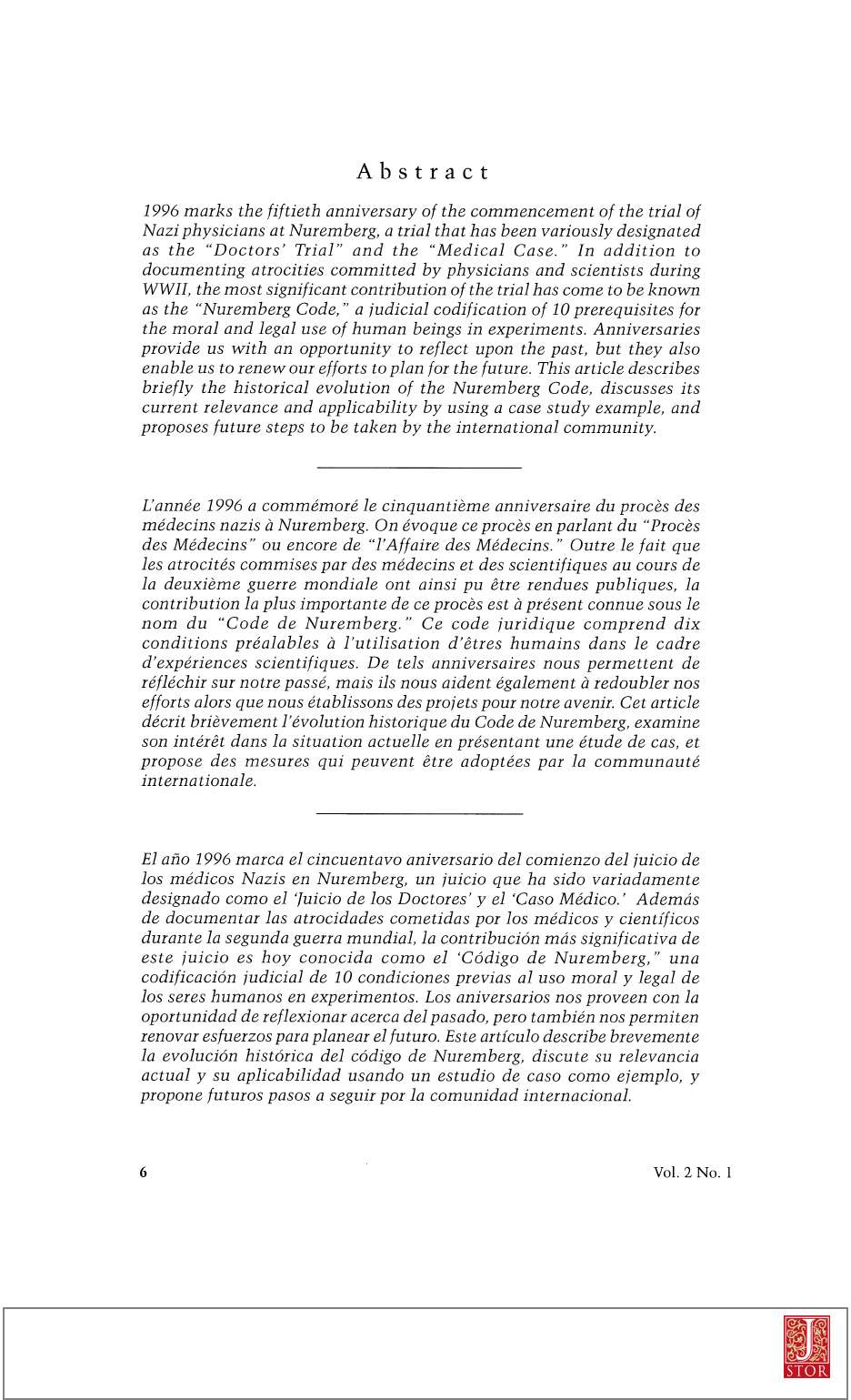
A
bstract
1996
marks the
fiftieth
anniversary of
the
commencement
of the
trial of
Nazi
physicians
at
Nuremberg,
a trial
that has been
variously
designated
as the
"Doctors' Trial"
and the
"Medical
Case."
In
addition to
documenting
atrocities
committed
by
physicians and
scientists
during
WWII,
the most
significant contribution
of
the trial
has come to be known
as the
"Nuremberg
Code,"
a
judicial
codification
of
10
prerequisites
for
the moral and
legal
use
of
human
beings
in
experiments. Anniversaries
provide us
with an
opportunity to
reflect upon
the past,
but they
also
ena ble us to renew our
efforts
to
plan for
the
future. This article describes
briefly
the historical
evolution
of
the
Nuremberg Code,
discusses its
current relevance and
applicability by
using
a case
study
example,
and
proposes future
steps
to be taken
by
the international
community.
L'ann?e 1996 a comm?mor?
le
cinquanti?me anniversaire du
proc?s
des
m?decins nazis ?
Nuremberg.
On
?voque
ce
proc?s
en
parlant
du
"Proc?s
des
M?decins"
ou
encore de
"l'Affaire
des
M?decins." Outre le
fait
que
les atrocit?s
commises
par
des
m?decins et des
scientifiques au cours de
la
deuxieme
guerre mondiale
ont ainsi
pu etre
rendues
publiques,
la
contribution la
plus
importante
de ce
proc?s
est
?
pr?sent
connue sous le
nom du
"Code
de
Nuremberg." Ce code
juridique
comprend
dix
conditions
pr?alables ? l'utilisation d'?tres
humains dans le cadre
d'exp?riences
scientifiques.
De tels
anniversaires
nous
permettent
de
r?fl?chir
sur notre
pass?,
mais ils nous
aident
?galement ?
redoubler nos
efforts
alors
que
nous
?tablissons des
projets pour
notre avenir.
Cet
article
d?crit
bri?vement
l'?volution
historique
du
Code
de
Nuremberg,
examine
son int?r?t dans la
situation actuelle en
pr?sentant
une ?tude de
cas,
et
propose
des mesures
qui
peuvent ?tre
adopt?es par la
communaut?
interna tionale.
El
ano
1996 marca el
cincuentavo
aniversario del
comienzo
del
juicio
de
los m?dicos
Nazis en
Nuremberg,
un
juicio
que
ha sido
variadamente
designado
como el
'Juicio
de los Doctores'
y
el
'Caso M?dico.' Adem?s
de documentar las
atrocidades
cometidas
por
los m?dicos
y
cientificos
durante la
segunda guerra
mundial,
la contribuci?n
mas
significativa
de
este
juicio
es
hoy
conocida
como el
'C?digo
de
Nuremberg,"
una
codificaci?n
judicial
de 10
condiciones
previas
al
uso moral
y legal
de
los seres humanos en
experimentos.
Los aniversarios
nos
proveen
con la
oportunidad
de
reflexionar
acerca
del
pasado, pero
tambi?n nos
permiten
renovar
esfuerzos
para
planear
el
futuro.
Este articulo
describe
brevemente
la evoluci?n hist?rica
del
c?digo
de
Nuremberg,
discute su
relevancia
actual
y
su
aplicabilidad
usando un
estudio de
caso como
ejemplo, y
propone futuros
pasos
a
seguir
por
la comunidad
internacional.
6
Vol.
2
No.
1
The President and Fellows of Harvard College
is collaborating with JSTOR to digitize, preserve, and extend access to
Health and Human Rights
www.jstor.org
®
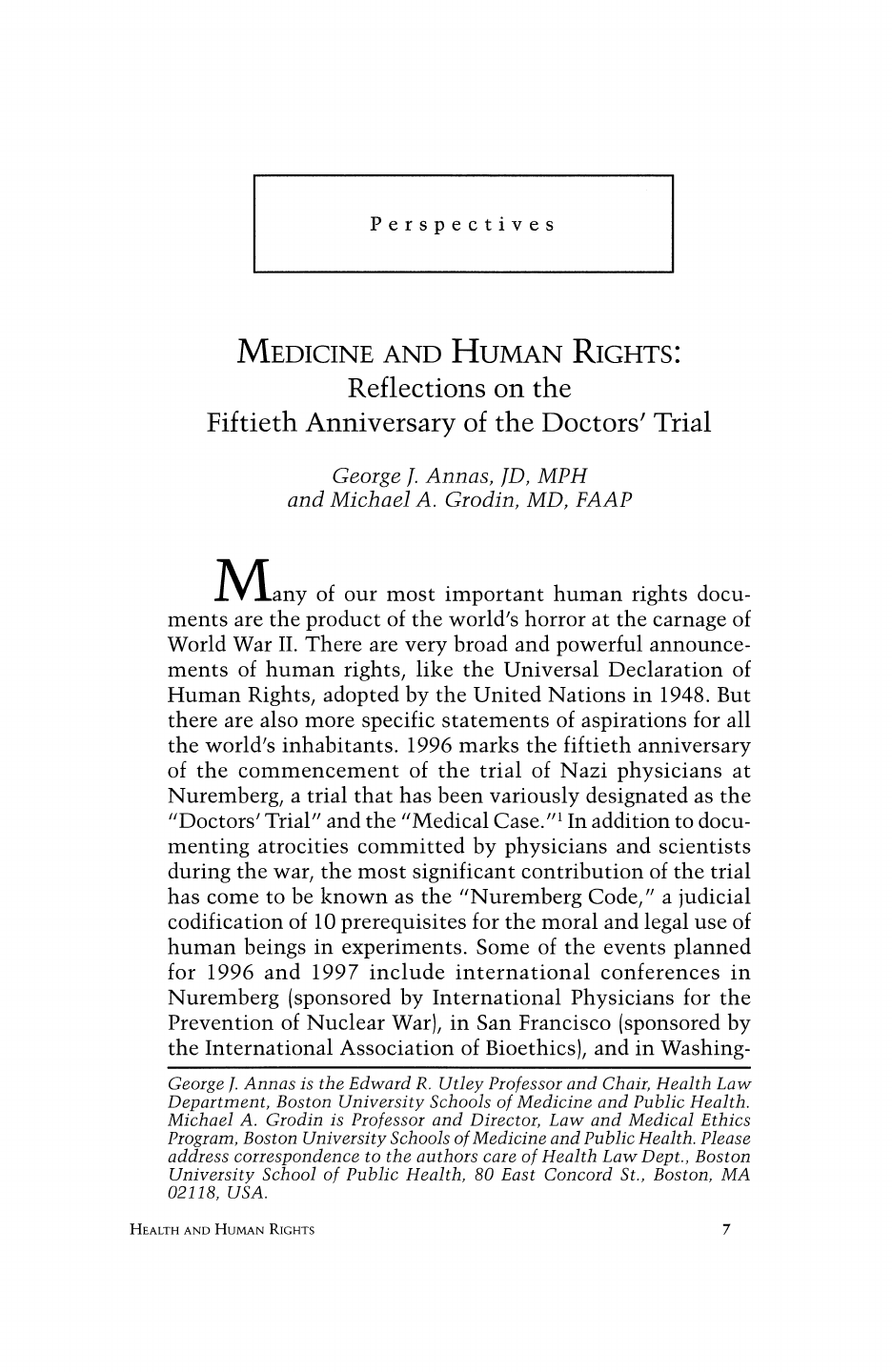
Perspectives
MEDICINE
AND
HUMAN RIGHTS:
Reflections
on
the
Fiftieth
Anniversary
of the
Doctors'
Trial
George J. Annas, JD,
MPH
and Michael A. Grodin,
MD, FAAP
jMiany
of
our most important human rights docu-
ments are the
product
of the world's horror at the
carnage
of
World War
II. There are
very
broad and
powerful
announce-
ments of human
rights,
like the
Universal Declaration
of
Human
Rights, adopted by
the
United Nations
in
1948.
But
there are
also more
specific
statements of
aspirations
for all
the world's inhabitants.
1996
marks the fiftieth
anniversary
of the commencement of the trial of Nazi
physicians
at
Nuremberg,
a trial that has been
variously designated
as
the
"Doctors'
Trial" and the "Medical
Case."'`
In
addition to docu-
menting
atrocities committed
by physicians
and scientists
during
the
war,
the most
significant
contribution of the trial
has
come to be known as the
"Nuremberg Code,"
a
judicial
codification
of 10
prerequisites
for the moral and
legal
use
of
human
beings
in
experiments.
Some of the events
planned
for
1996
and
1997
include international conferences
in
Nuremberg
(sponsored
by
International
Physicians
for
the
Prevention
of Nuclear
War),
in
San Francisco
(sponsored by
the International Association of
Bioethics),
and
in
Washing-
George
J. Annas is the Edward R.
Utley Professor
and
Chair, Health
Law
Department, Boston University Schools of Medicine and Public Health.
Michael A. Grodin is Professor
and
Director, Law
and Medical Ethics
Program, Boston University Schools of Medicine and
Public Health. Please
address
correspondence
to the authors
care
of
Health Law Dept., Boston
University School of Public Health, 80 East Concord
St., Boston,
MA
02118,
USA.
HEALTH AND HUMAN RIGHTS 7
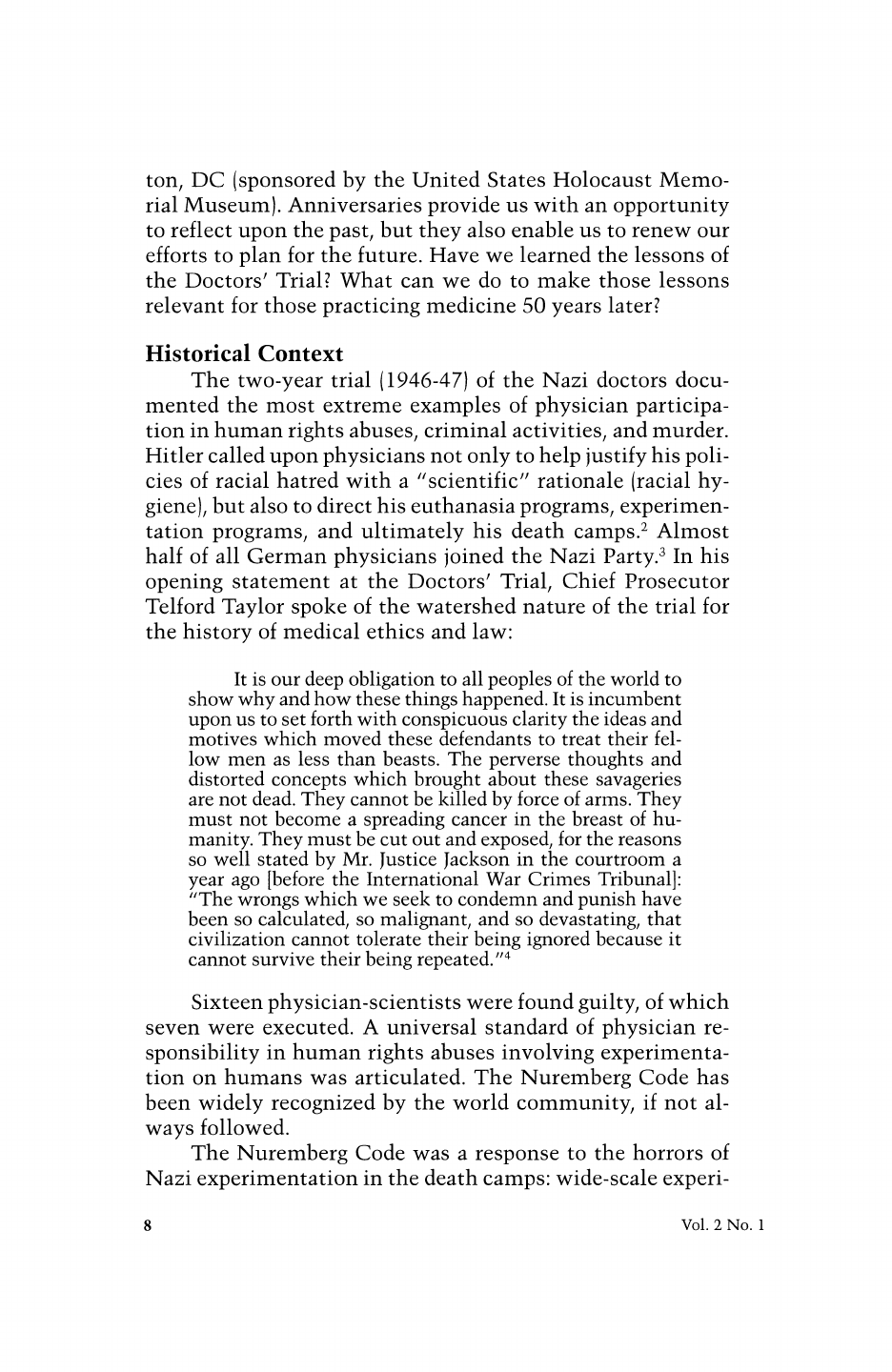
ton, DC (sponsored by the
United States Holocaust
Memo-
rial
Museum).
Anniversaries
provide us with an opportunity
to reflect upon the past,
but they also enable
us to renew our
efforts to plan for the future.
Have we
learned the lessons of
the Doctors'
Trial?
What can we do
to make those lessons
relevant
for those
practicing
medicine 50 years later?
Historical Context
The
two-year
trial
(1946-47)
of the Nazi doctors docu-
mented the most extreme
examples
of
physician
participa-
tion
in
human
rights
abuses, criminal activities,
and murder.
Hitler called upon physicians
not only to help justify
his poli-
cies of racial hatred with a "scientific"
rationale
(racial
hy-
giene), but also to direct
his euthanasia programs, experimen-
tation
programs,
and ultimately his death camps.2
Almost
half of
all
German
physicians
joined
the Nazi
Party.3
In
his
opening
statement at the Doctors'
Trial,
Chief Prosecutor
Telf ord
Taylor spoke
of the watershed nature of the trial for
the
history
of medical ethics and law:
It is our deep obligation
to all peoples of the world
to
show
why
and how these
things happened.
It is incumbent
upon
us to
set
forth with
conspicuous clarity
the ideas and
motives which moved these defendants to treat their fel-
low men as less than beasts. The
perverse thoughts
and
distorted
concepts
which
brought
about these
savageries
are not dead.
They
cannot be killed
by
force of arms.
They
must not become a
spreading
cancer
in
the breast of
hu-
manity. They
must be cut out and
exposed,
for the reasons
so well
stated
by
Mr. Justice
Jackson
in
the courtroom a
year ago [before
the International War Crimes
Tribunal]:
"The
wrongs
which
we seek to
condemn and
punish
have
been so
calculated,
so malignant,
and so
devastating,
that
civilization
cannot tolerate their
being ignored
because it
cannot survive their
being repeated."4
Sixteen
physician-scientists
were found
guilty,
of
which
seven were executed.
A
universal
standard of
physician
re-
sponsibility
in
human
rights
abuses
involving experimenta-
tion on humans was articulated.
The
Nuremberg
Code
has
been
widely recognized
by
the
world
community,
if
not al-
ways
followed.
The
Nuremberg
Code
was a
response
to the horrors of
Nazi
experimentation
in the death
camps:
wide-scale
experi-
8
Vol. 2 No.
1

mentation
without consent,
which
often
had
the death of
the
prisoner-subject
as
its planned endpoint.
The Code
has
10 provisions,
two
designed
to protect
the rights
of
subjects
of human
experimentation,
and eight
designed
to protect
their
welfare.
The best known
is its first, the consent
requirement,
which states
in
part:
The voluntary
consent
of the human
subject
is
abso-
lutely
essential.
This
means
that the person
involved
should
have legal capacity
to
give consent;
should
be so
situated
as to be able
to exercise free
power
of choice,
without the
intervention
of
any
element
of force,
fraud,
deceit,
duress,
overreaching,
or other
ulterior form of constraint
or
coer-
cion;
and should
have sufficient
knowledge
and
compre-
hension
of the elements of
the
subject
matter
involved
as
to enable
him to make
an understanding
and
enlightened
decision....5
Although
the Nuremberg
Code
has never
been
formally
adopted
as a whole
by
the
United
Nations
(UN),
a statement
related
to torture appears
as Article 5
of
the Universal
Decla-
ration of
Human
Rights.
A second sentence
added to
the text
of Article
5,
which
further reflects
the concerns
of
the
Nuremberg
Code,
appears
as Article
7
of the UN
Interna-
tional
Covenant
on
Civil
and Political
Rights.
It states:
No one shall be
subjected
to torture or
to
cruel,
inhu-
man
or
degrading
treatment
or
punishment.
In
particular,
no one shall be
subjected
without his [sic]
free
consent to
medical or
scientific
experimentation.6
Most physicians
would,
of course,
be shocked
at
having
any
assistance
they give
to
patients
considered
"torture
or...cruel,
inhuman or
degrading
treatment."
They
would thus
view the
Covenant's provisions
in much the same way
most
physicians
view the Nuremberg Code:
as
a
legal
document
not
applicable
to actions taken
by
physicians.
But
this is a
mistake,
and
only
helps protect
aberrant
physicians
by
marginalizing
their actions
as nonmedical
in nature
and there-
fore
of no concern
to the medical
profession.
It is when
a
doctor
disregards
a
person's
bodily
integrity
that
torture and
involuntary
human
experimentation
become
virtually
indis-
tinguishable.7
HEALTH
AND
HUMAN
RIGHTS
9

The World
Medical
Association
In
late
1946,
100
delegates
representing 32
national
medi-
cal
associations met in
London
to
form
the
world's
first
in-
ternational
medical
organization. The
World
Medical
Asso-
ciation
(WMA)
was
created
to
promote ties
between
national
medical
organizations and
among
doctors
around the
world.
Its
objectives
are:
*
To
promote
closer
ties
among
national
medical
organizations and
among
the
doctors of the
world
by
personal
contact
and all
other
means
available;
*
To
maintain
the
honor and
protect the
interests of
the
medical
profession;
*
To
study
and
report
on
the
professional
problems
which
confront the
medical
profession
in
different
countries;
*
To
organize
an
exchange
of
information
on
matters
of
interest to
the
medical
profession;
*
To
establish
relations with,
and to
present the
views
of
the
medical
profession
to the
World Health
Organization
(WHO),
the United
Nations
Education,
Science and
Culture
Organization
(UNESCO),
and
other
appropriate
bodies;
*
To
assist all
peoples
of
the world
to attain
the
highest
possible
level of
health;
and,
*
To
promote
world
peace.8
In
September
1947,
shortly after
the final
judgment
at
the
Doctors'
Trial,
the
first official
meeting
of the WMA
was
held
in
Paris.
The WMA
formulated
a new
physician oath to
promote
and
serve
the health
of
humanity.
This was
followed
by
discussion of
the
"principles
of social
security."
Key prin-
ciples
adopted included:
*
Freedom of
every
physician
to
choose his
[sic]
location
and
type
of
practice;
*
All medical
services
to be
controlled
by
physicians;
*
That
it is
not
in
the
public's
interest that
doctors be
full-time
salaried
servants of
government
or
social-security
bodies;
10
Vol. 2
No.
1
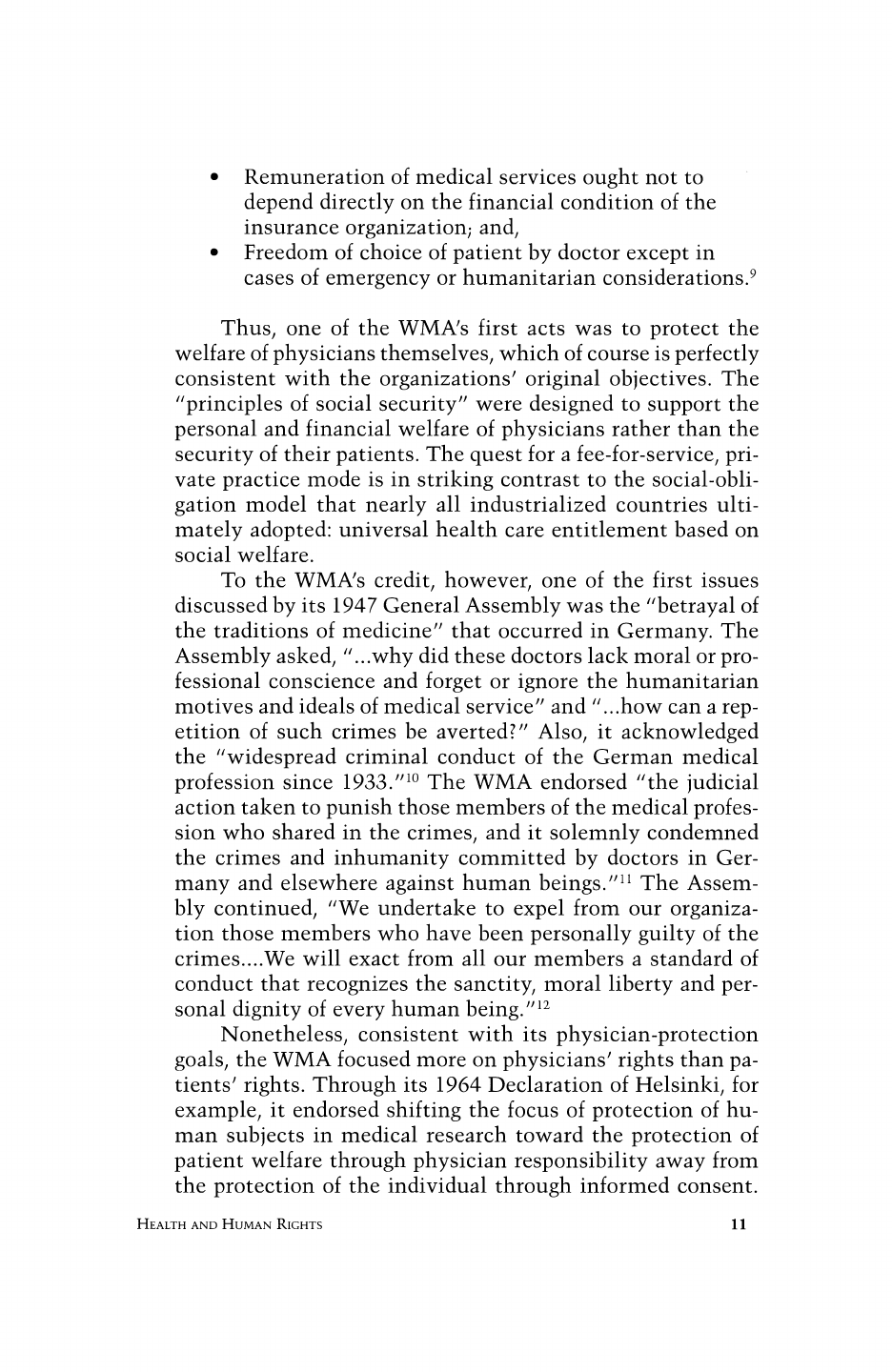
*
Remuneration of medical services
ought
not to
depend
directly
on the financial condition of
the
insurance organization; and,
*
Freedom
of choice of
patient by
doctor
except
in
cases of
emergency
or humanitarian
considerations.9
Thus, one of the WMA's first acts was to
protect the
welfare of physicians themselves, which of course is
perfectly
consistent
with the
organizations' original objectives. The
"principles of social security" were designed to
support
the
personal
and financial welfare of
physicians rather
than
the
security
of their
patients.
The
quest for a
fee-for-service, pri-
vate
practice
mode is
in
striking
contrast to the social-obli-
gation
model that
nearly
all industrialized countries ulti-
mately adopted:
universal health care entitlement based on
social welf are.
To
the WMA's
credit, however,
one of the first issues
discussed
by
its
1947
General
Assembly
was the
"betrayal
of
the traditions of medicine" that
occurred
in
Germany.
The
Assembly asked, "...why
did
these doctors lack moral or
pro-
fessional conscience and
forget
or
ignore
the humanitarian
motives
and ideals
of
medical
service" and "...how can a
rep-
etition of such crimes be averted?" Also, it
acknowledged
the
"widespread
criminal conduct
of the German medical
profession
since
1933."10
The
WMA
endorsed "the
judicial
action taken to
punish
those members of the medical
profes-
sion who shared
in
the
crimes,
and it
solemnly
condemned
the crimes and
inhumanity
committed
by
doctors
in
Ger-
many
and elsewhere
against
human
beings.""1
The Assem-
bly continued,
"We
undertake
to
expel
from our
organiza-
tion those members who have been
personally
guilty
of the
crimes
....
We will exact from all our
members a standard of
conduct that
recognizes
the
sanctity,
moral
liberty
and
per-
sonal
dignity
of
every
human
"being.
l12
Nonetheless,
consistent with its
physician-protection
goals,
the WMA focused more on
physicians' rights
than
pa-
tients'
rights. Through
its
1964
Declaration of
Helsinki,
for
example,
it endorsed
shifting
the focus of
protection
of hu-
man
subjects
in
medical research toward the
protection
of
patient
welfare
through physician responsibility
away
from
the
protection
of the individual
through
informed consent.
HEALTH AND
HUMAN
RIGHTS
11
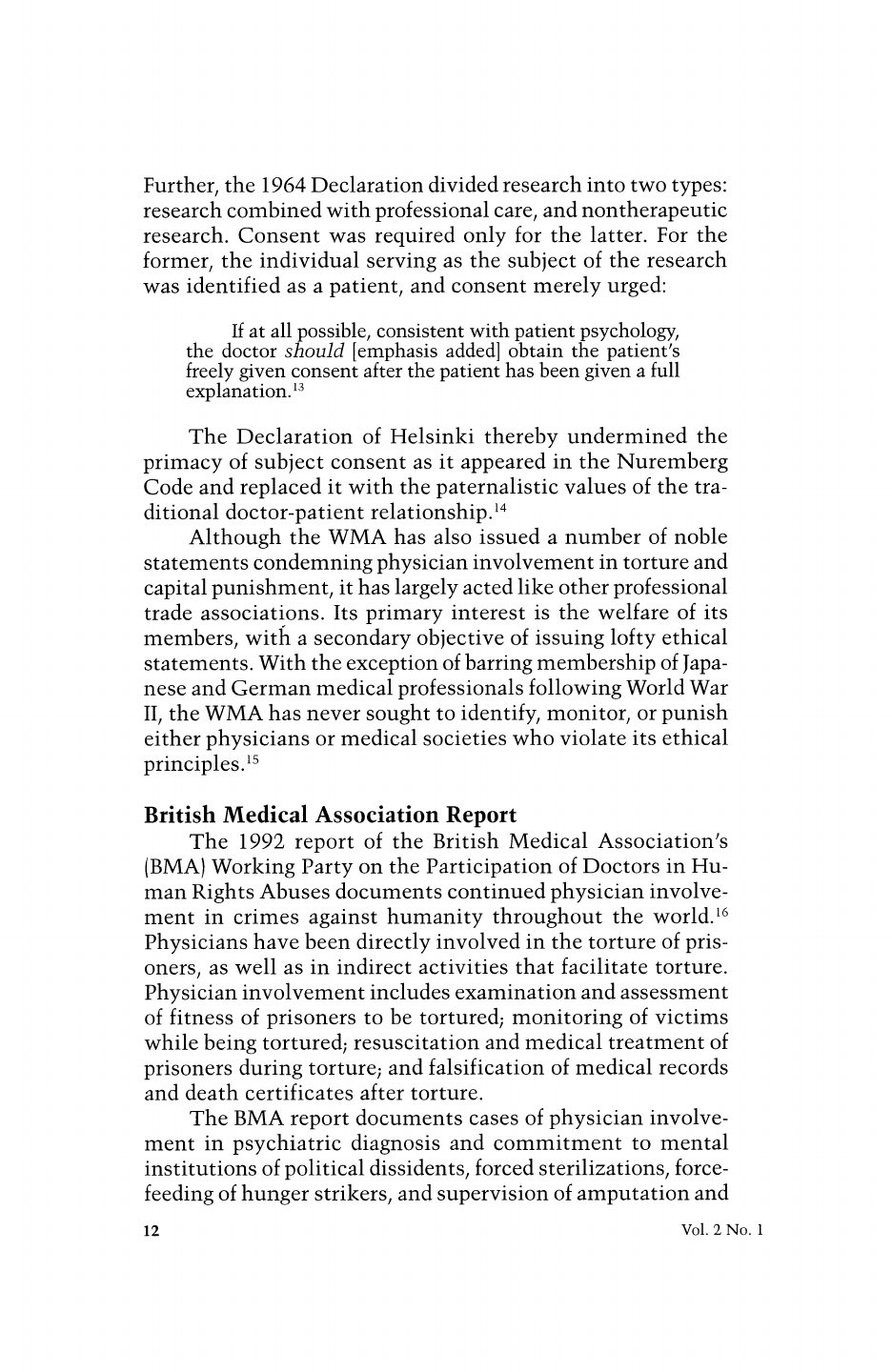
Further,
the
1964 Declaration
divided
research
into
two types:
research
combined
with
professional
care,
and nontherapeutic
research.
Consent
was
required
only
for the latter.
For
the
former,
the individual serving
as the subject
of the research
was
identified
as a
patient,
and consent
merely
urged:
If
at
all possible,
consistent
with
patient psychology,
the doctor
should
[emphasis
added] obtain
the
patient's
freely given
consent
after
the patient
has been given
a full
explanation.'3
The
Declaration of
Helsinki
thereby
undermined the
primacy
of
subject
consent
as it
appeared
in the
Nuremberg
Code
and
replaced
it with
the
paternalistic
values
of the tra-
ditional
doctor-patient
relationship.14
Although
the WMA has also
issued a number of
noble
statements
condemning physician
involvement
in torture and
capital
punishment,
it has
largely
acted like other
professional
trade
associations.
Its primary
interest is the
welfare
of its
members,
with a
secondary
objective
of
issuing lofty
ethical
statements.
With the
exception
of
barring
membership
of
Japa-
nese and German
medical
professionals
following
World War
II, the
WMA has never
sought
to identify,
monitor, or punish
either
physicians
or
medical societies who violate
its ethical
principles.
15
British
Medical Association
Report
The 1992
report
of
the British Medical
Association's
(BMA)
Working Party
on the
Participation
of Doctors
in Hu-
man
Rights
Abuses documents continued
physician
involve-
ment
in
crimes
against
humanity
throughout
the world.'6
Physicians
have
been
directly
involved
in
the torture
of
pris-
oners,
as well
as
in
indirect activities
that facilitate
torture.
Physician
involvement
includes
examination and assessment
of fitness
of
prisoners
to
be
tortured;
monitoring
of victims
while
being
tortured;
resuscitation
and
medical treatment
of
prisoners
during
torture;
and falsification of
medical records
and death
certificates after
torture.
The
BMA
report
documents
cases
of
physician
involve-
ment
in
psychiatric
diagnosis
and
commitment to
mental
institutions
of
political
dissidents,
forced
sterilizations,
force-
feeding
of
hunger
strikers,
and
supervision
of
amputation
and
12
Vol. 2 No.
1
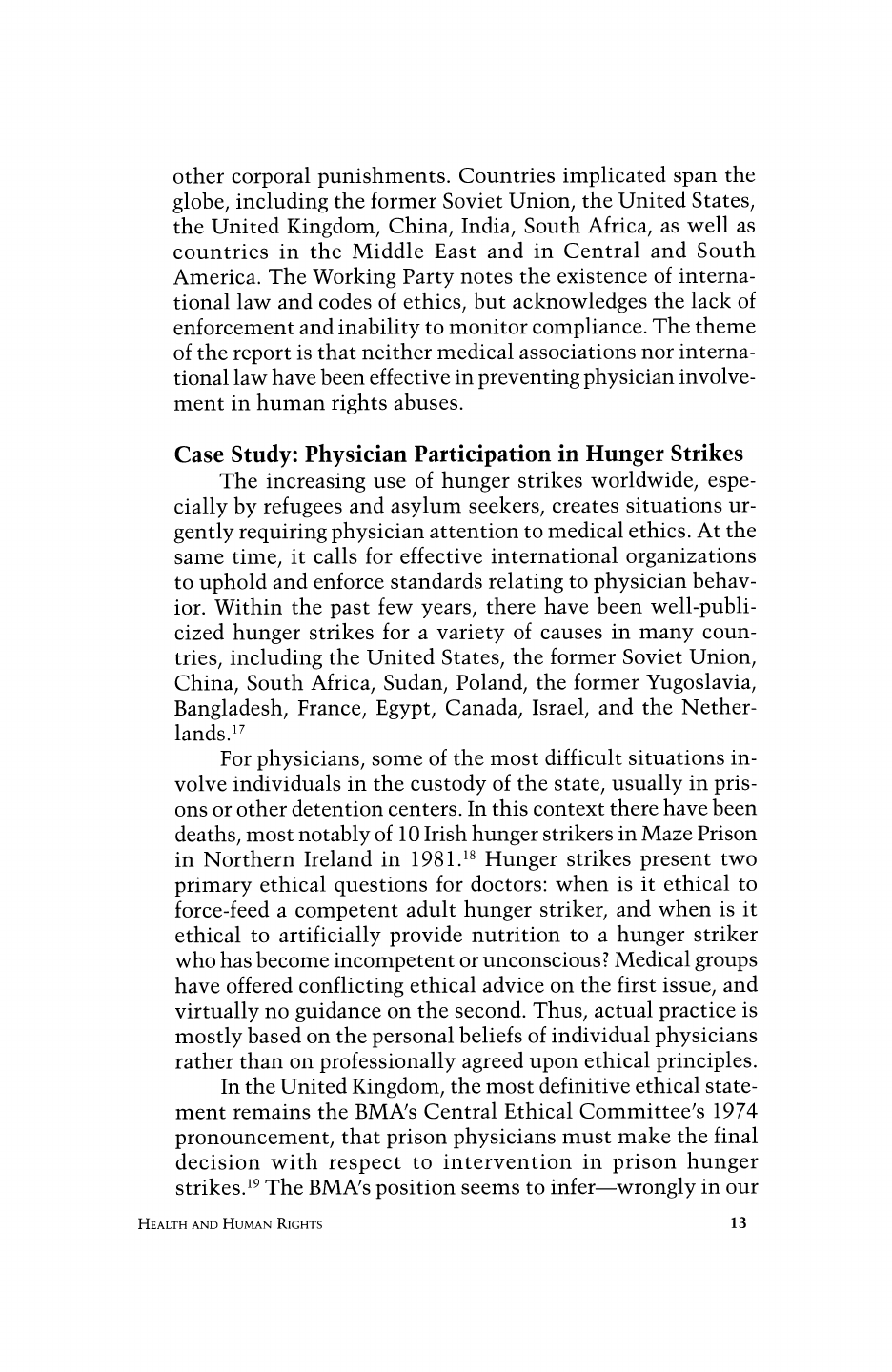
other corporal
punishments.
Countries
implicated
span
the
globe,
including
the former
Soviet
Union,
the United
States,
the United
Kingdom,
China,
India,
South
Africa,
as
well
as
countries
in the
Middle
East
and
in Central
and
South
America.
The
Working
Party
notes
the
existence
of
interna-
tional
law and codes
of ethics,
but
acknowledges
the lack
of
enforcement
and inability
to monitor
compliance.
The
theme
of the report
is that neither
medical associations
nor
interna-
tional
law
have been effective
in
preventing
physician
involve-
ment
in human rights
abuses.
Case
Study:
Physician
Participation
in
Hunger
Strikes
The
increasing
use of hunger
strikes
worldwide,
espe-
cially
by
refugees
and asylum
seekers,
creates
situations
ur-
gently
requiring
physician
attention
to medical
ethics.
At
the
same time,
it calls for effective
international
organizations
to
uphold
and enforce
standards
relating
to
physician
behav-
ior.
Within
the
past
few years,
there have
been well-publi-
cized hunger
strikes
for
a
variety
of
causes
in many
coun-
tries,
including
the United
States,
the former
Soviet
Union,
China,
South
Africa,
Sudan,
Poland,
the former
Yugoslavia,
Bangladesh,
France,
Egypt,
Canada,
Israel,
and the
Nether-
lands.'7
For
physicians,
some of
the most difficult
situations
in-
volve
individuals
in
the
custody
of
the
state,
usually
in
pris-
ons or other
detention
centers.
In this context
there
have been
deaths,
most
notably
of 10
Irish
hunger
strikers
in
Maze Prison
in Northern
Ireland
in
1981.18
Hunger
strikes
present
two
primary
ethical questions
for doctors:
when
is it ethical
to
force-feed
a
competent
adult
hunger
striker,
and
when
is it
ethical
to
artificially provide
nutrition
to a
hunger
striker
who
has become
incompetent
or
unconscious?
Medical
groups
have
offered conflicting
ethical
advice
on
the first
issue,
and
virtually
no
guidance
on
the second.
Thus,
actual
practice
is
mostly
based on
the
personal
beliefs of
individual
physicians
rather
than
on
professionally
agreed
upon
ethical
principles.
In the United
Kingdom,
the most
definitive ethical
state-
ment remains
the
BMA's Central
Ethical Committee's
1974
pronouncement,
that
prison
physicians
must make
the final
decision
with
respect
to intervention
in
prison
hunger
strikes.19
The
BMA's
position
seems to infer-wrongly
in
our
HEALTH
AND
HUMAN
RIGHTS
13
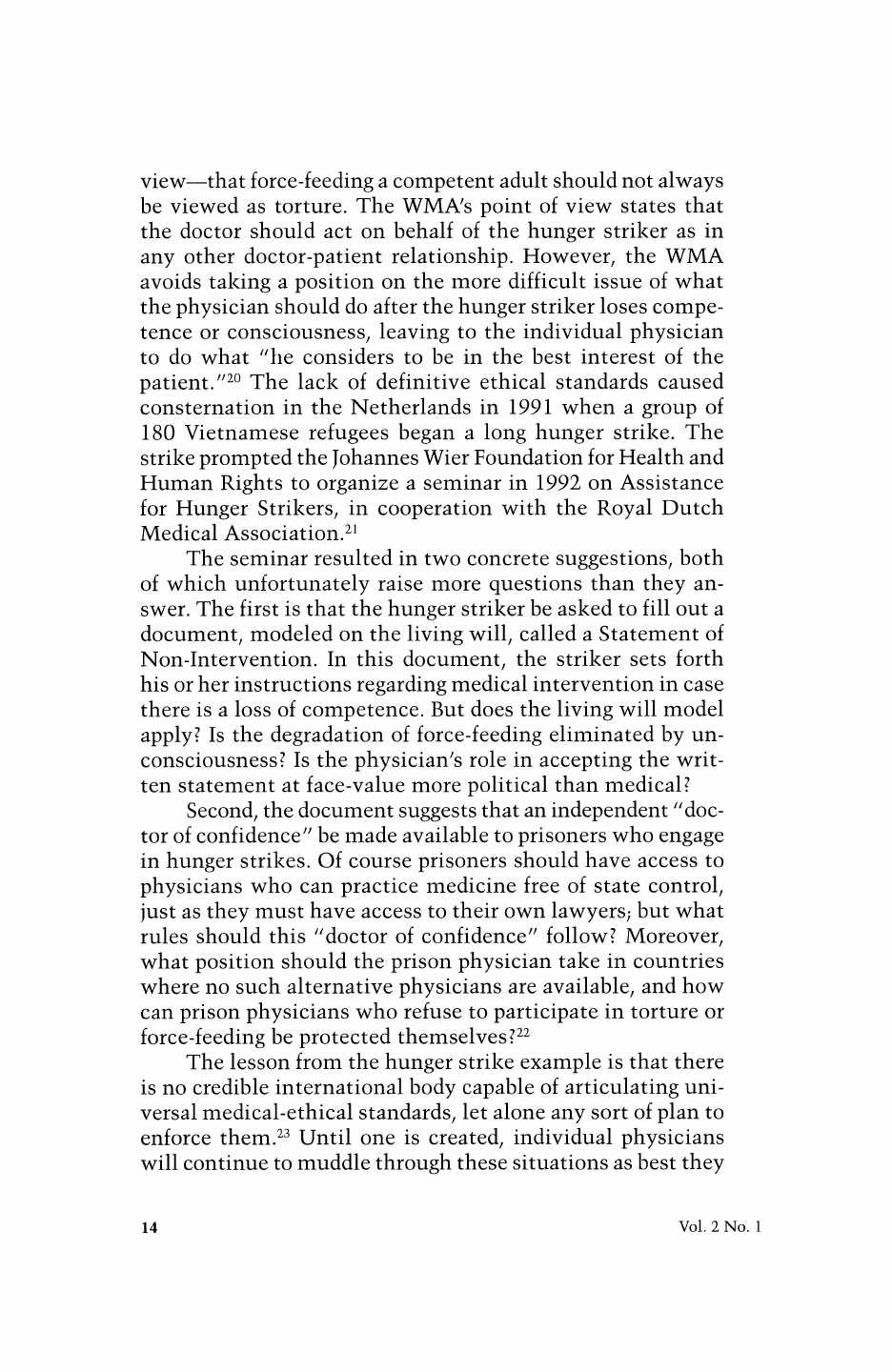
view-that
force-feeding
a
competent
adult should
not always
be viewed
as torture.
The WMA's
point of
view states
that
the doctor
should
act on
behalf of
the hunger
striker
as in
any other
doctor-patient
relationship.
However,
the
WMA
avoids
taking
a
position
on the
more difficult
issue of
what
the
physician
should
do after the
hunger striker
loses compe-
tence
or consciousness,
leaving
to
the individual
physician
to do
what "lie
considers
to be
in the best interest
of
the
patient."20
The lack of definitive ethical
standards caused
consternation
in the Netherlands
in
1991
when
a
group
of
180
Vietnamese
refugees
began
a
long
hunger strike.
The
strike prompted
the
Johannes
Wier Foundation
for Health
and
Human
Rights
to
organize
a
seminar
in
1992
on Assistance
for Hunger Strikers,
in
cooperation
with the Royal
Dutch
Medical
Association.2'
The seminar
resulted
in
two concrete suggestions,
lboth
of which unfortunately
raise
more
questions
than they
an-
swer. The
first is that the hunger striker
be asked to
fill
out
a
document,
modeled on the living
will, called
a Statement
of
Non-Intervention.
In this
document,
the striker
sets forth
his or her
instructions
regarding
medical
intervention
in
case
there is a
loss of
competence.
But
does the
living
will model
apply?
Is the
degradation
of
force-feeding
eliminated
by
un-
consciousness?
Is
the
physician's
role
in
accepting
the writ-
ten statement
at face-value
more
political
than medical?
Second,
the document
suggests
that an
independent
"doc-
tor of confidence"
be
made available to
prisoners
who
engage
in
hunger
strikes. Of course prisoners
should
have access to
physicians
who can
practice
medicine free of state
control,
just
as
they
must have
access to their own
lawyers;
but what
rules should
this "doctor of confidence"
follow?
Moreover,
what
position
should the
prison physician
take
in
countries
where
no such alternative
physicians
are
available,
and how
can
prison
physicians
who
refuse to
participate
in torture or
force-feeding
be
protected
themselves
?22
The lesson
from the
hunger
strike
example
is
that there
is
no credible
international
body
capable
of
articulating
uni-
versal
medical-ethical
standards,
let alone
any
sort of
plan
to
enforce
them.23
Until
one is
created,
individual
physicians
will continue
to muddle
through
these situations
as best
they
14
Vol. 2
No.
1
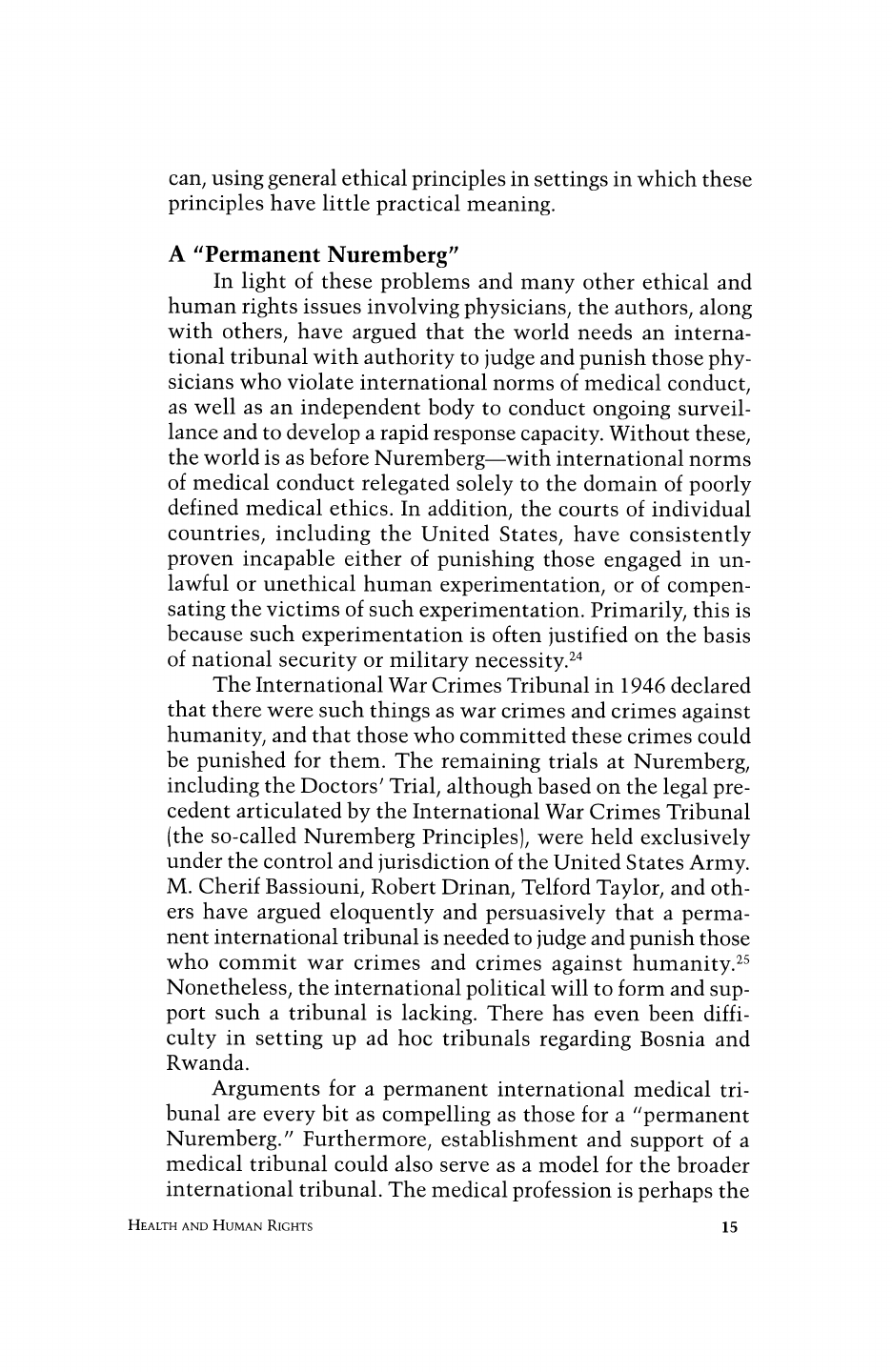
can,
using
general ethical
principles in
settings
in
which
these
principles
have
little
practical
meaning.
A
"Permanent
Nuremberg"
In
light
of
these
problems and
many
other
ethical and
human
rights
issues
involving
physicians,
the
authors,
along
with
others,
have
argued
that
the
world
needs an
interna-
tional
tribunal
with
authority to
judge
and
punish
those
phy-
sicians who
violate
international
norms
of medical
conduct,
as well
as an
independent
body
to
conduct
ongoing surveil-
lance
and to
develop
a
rapid
response
capacity.
Without
these,
the world
is as
before
Nuremberg-with
international
norms
of
medical
conduct
relegated
solely to
the domain of
poorly
defined
medical
ethics. In
addition,
the courts of
individual
countries,
including
the
United
States,
have
consistently
proven
incapable either
of
punishing those
engaged
in
un-
lawful
or
unethical
human
experimentation, or of
compen-
sating
the
victims of
such
experimentation.
Primarily,
this
is
because
such
experimentation
is often
justified on the
basis
of
national
security
or
military
necessity.24
The
International
War
Crimes
Tribunal
in
1946 declared
that
there
were such
things as war
crimes and crimes
against
humanity,
and that
those
who
committed
these
crimes
could
be
punished for
them.
The
remaining
trials at
Nuremberg,
including
the
Doctors'
Trial,
although
based on the
legal
pre-
cedent
articulated
by
the
International
War
Crimes
Tribunal
(the
so-called
Nuremberg
Principles),
were
held
exclusively
under the
control
and
jurisdiction of
the
United States
Army.
M.
Cherif
Bassiouni,
Robert
Drinan,
Telford
Taylor,
and
oth-
ers
have
argued
eloquently
and
persuasively
that a
perma-
nent
international
tribunal
is
needed to
judge
and
punish
those
who
commit
war
crimes
and
crimes
against
humanity.25
Nonetheless,
the
international
political will to form
and
sup-
port
such a
tribunal
is
lacking.
There
has even
been diffi-
culty
in
setting
up
ad
hoc
tribunals
regarding
Bosnia
and
Rwanda.
Arguments
for a
permanent
international
medical tri-
bunal are
every
bit as
compelling
as
those for
a
"permanent
Nuremberg."
Furthermore,
establishment
and
support
of a
medical
tribunal could
also
serve
as a
model for the
broader
international
tribunal. The
medical
profession
is
perhaps
the
HEALTH
AND
HUMAN
RIGHTS
15

best entity
to take
a leading role
in this regard.
That
is be-
cause
it has an apolitical
history;
has consistently
argued
for
at least
some neutrality
in wartime
to aid
the
sick and
wounded;
has a basic
humanitarian
purpose
for its existence;
and
regards
physician
acts intended
to
destroy
human health
and
life as
a
unique
betrayal
both
of societal
trust and
of
the
profession
itself.
Moreover,
it
is
much harder
for governments
to adopt
inherently
evil and
destructive
policies
if
they
are
denied
the
patina
of
legitimacy
that
physician
approval
pro-
vides.
An
International
Medical
Tribunal
Medicine and
law are often viewed
as
opponents,
but
in
the
promotion
of human
rights
regarding
health
they
have
a
common agenda.
In
1992,
the world's physicians
and
lawyers
were
urged
to work
together
to form
and
support
an interna-
tional
medical
tribunal.26
Ideally,
such a
body
would be es-
tablished
with
the sanction
and authority
of the
United
Na-
tions.
However,
given
the competing
political
agendas
of the
member
States,
as evidenced
by
recent controversies
at
WHO,
initial
failure to win
UN approval
and
support
should
not
doom
this
project.
Even
if
unable to
punish
with criminal
sanctions,
a tribunal could
hear
cases,
develop
an
interna-
tional
code,
and
publicly
condemn
actions of individual phy-
sicians
who violate
international
standards of medical
con-
duct.
Establishment
and
support
of such a tribunal
is a wor-
thy
project
for
the world's
physicians
and
lawyers.27
To
move
forward,
establishment
of such an international
medical
tribunal could become
part
of the
advocacy
efforts
of medical
and
legal
associations around
the world. Because
the tribunal
must be both
authoritative
and
politically
neu-
tral,
no
single
country
or
political
philosophy
could
be
per-
mitted to
dominate
it,
either
by
having
a
disproportionate
representation
on the
tribunal or
by disproportionately
fund-
ing
it. The
tribunal itself should
be
composed
of
a
large panel
of
distinguished
judges,
the selective
recruitment
of which
would
be
necessary
for the tribunal's
credibility.
Governments
would
have to
support
the tribunal
in
a
variety
of
ways,
rang-
ing
from the
funding
of its
infrastructure to permitting
se-
lected
judges
to take time off
from their full-time
judicial
duties
to hear
cases.28
16
Vol. 2
No.
1

Other Steps the International Community Can Take
Steps
should
be taken at the level of national
medical
licensure boards (and state boards in countries in which po-
litical subdivisions have medical licensing authority) to ar-
ticulate specific rules denouncing physicians who commit
war crimes
and
crimes
against humanity.
Those
found to have
been involved
in
such crimes would lose their license to
prac-
tice medicine, or be ineligible to obtain one if they were not
yet physicians. Physicians
who lost their license
to
practice
medicine for war crimes or crimes against humanity in one
jurisdiction would
be
prohibited from practicing medicine
in
all
jurisdictions. Licensing agencies
themselves could enter
into a
compact
or
agreement
to
adopt
and enforce these rules
and
goals.
A
central registry of physicians who have been found to
have participated
in war
crimes or crimes against humanity
could then be established. The
registry
could be
kept by
an
independent nongovernmental organization comprised
of in-
ternational physicians, lawyers, and jurists. The registry
would also be a
repository
of
evidence,
such as affidavits and
sworn
testimony,
that could be used
by licensing agencies.
Prior to
licensing physicians, licensing agencies
would
query
the central
registry.
The creation and
use
of
such
a
registry is
especially important
in
instances where countries authorize
and use
physicians
to violate human
rights,
and where such
violations would otherwise
go unnoticed
and
unpunished.
We,
of
course,
realize
that
without an external
investigating
body
and a
functioning
tribunal it will
be difficult to
identify
these
physicians,
in that
they
are
carrying
out these viola-
tions
in
the name of the State. While this
licensing
sanction
is not as
strong
as one
might wish,
it
puts physicians
on no-
tice
that
should
an
investigation
or
adjudication
reveal their
involvement
in
human
rights
violations
they
would be un-
able to
practice
their
profession
outside of their own coun-
try.29
Conclusion
What lessons have we learned
from the Doctors'
Trial?
Three stand out:
1) Statements,
even
authoritative
statements,
of medi-
HEALTH AND HUMAN
RIGHTS
17
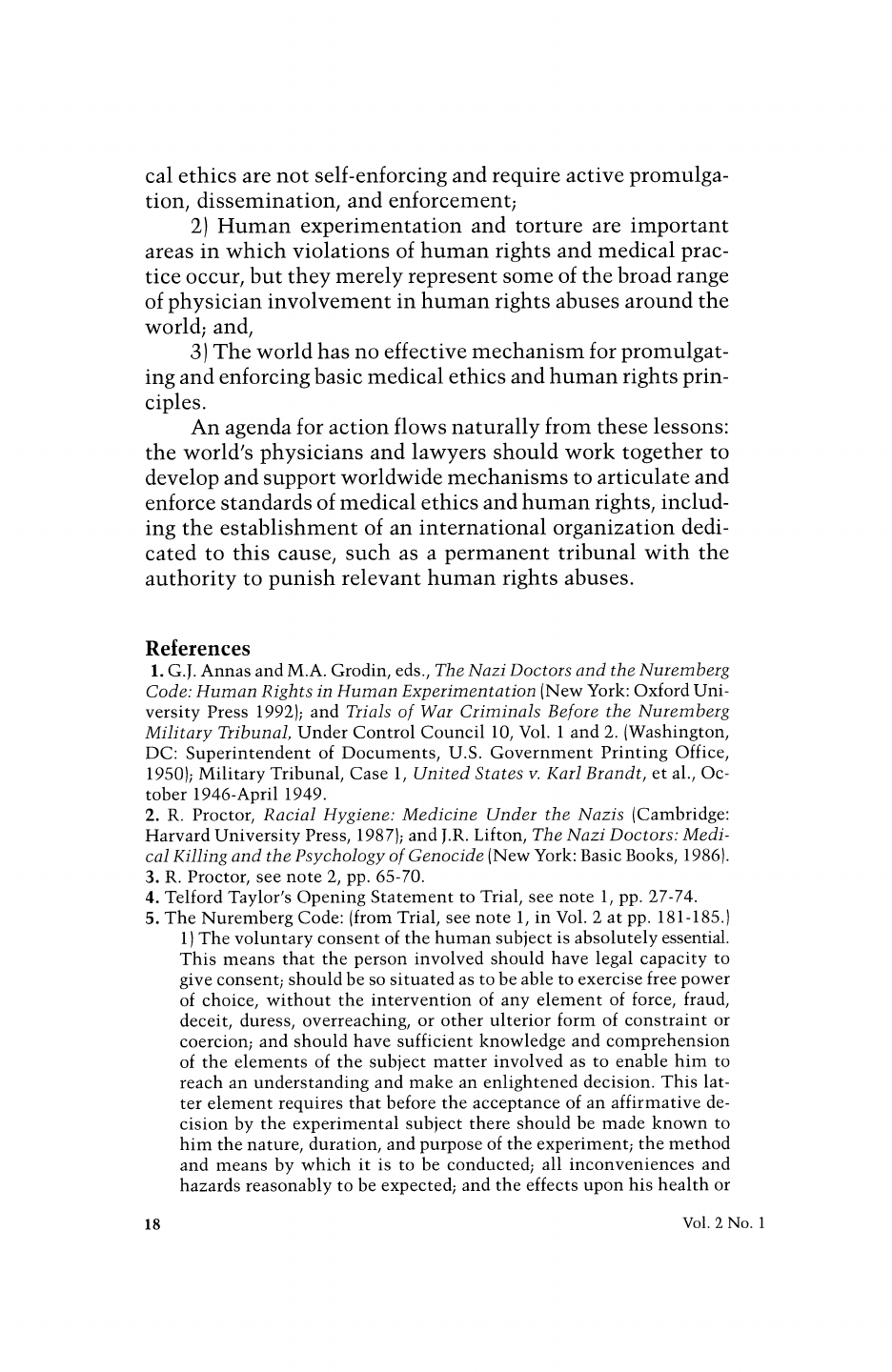
cal
ethics
are not
self-enforcing
and
require active
promulga-
tion,
dissemination,
and
enforcement;
2)
Human
experimentation
and
torture
are
important
areas
in
which
violations of human
rights
and medical
prac-
tice
occur,
but they merely
represent
some of the broad
range
of physician
involvement
in
human
rights
abuses around
the
world;
and,
3)
The world
has no effective
mechanism
for promulgat-
ing
and
enforcing
basic medical
ethics and human
rights
prin-
ciples.
An agenda
for action flows
naturally
from
these lessons:
the
world's
physicians
and lawyers
should
work
together
to
develop
and
support
worldwide
mechanisms to articulate
and
enforce standards
of medical
ethics and
human rights,
includ-
ing
the establishment
of an
international organization
dedi-
cated
to this
cause,
such as
a
permanent
tribunal
with
the
authority
to
punish
relevant
human
rights
abuses.
References
1.
G.J. Annas
and
M.A.
Grodin,
eds.,
The
Nazi Doctors
and the
Nuremberg
Code:
Human
Rights
in Human
Experimentation
(New
York: Oxford
Uni-
versity
Press 1992);
and
Trials
of
War Criminals
Before
the
Nuremberg
Military
Tribunal,
Under Control
Council 10,
Vol.
1
and 2.
(Washington,
DC: Superintendent
of Documents,
U.S.
Government
Printing
Office,
1950);
Military
Tribunal,
Case
1,
United
States
v. Karl
Brandt,
et
al., Oc-
tober 1946-April
1949.
2.
R. Proctor,
Racial
Hygiene:
Medicine
Under the Nazis
(Cambridge:
Harvard University
Press,
1987);
and J.R.
Lifton,
The
Nazi Doctors:
Medi-
cal
Killing
and the Psychology
of Genocide
(New
York:
Basic Books,
1986).
3. R. Proctor,
see
note
2, pp.
65-70.
4.
Telford
Taylor's
Opening
Statement
to
Trial,
see note
1,
pp. 27-74.
5.
The
Nuremberg
Code:
(from
Trial, see
note
1, in Vol.
2 at
pp.
181-185.)
1)
The voluntary
consent of
the human subject
is
absolutely
essential.
This
means
that
the person
involved
should
have
legal
capacity
to
give
consent;
should be so situated
as to be
able to
exercise
free
power
of choice,
without
the intervention
of any element
of
force,
fraud,
deceit, duress,
overreaching,
or other
ulterior
form
of
constraint
or
coercion;
and should
have sufficient
knowledge
and
comprehension
of
the elements
of the
subject
matter involved
as to enable
him to
reach
an understanding
and
make an
enlightened
decision.
This
lat-
ter
element
requires
that before
the
acceptance
of
an
affirmative
de-
cision by
the experimental
subject
there should be
made
known
to
him the nature,
duration, and
purpose
of the
experiment;
the
method
and
means
by
which
it is to be conducted;
all
inconveniences
and
hazards
reasonably
to be expected;
and the
effects
upon
his health
or
18
Vol.
2
No.
1
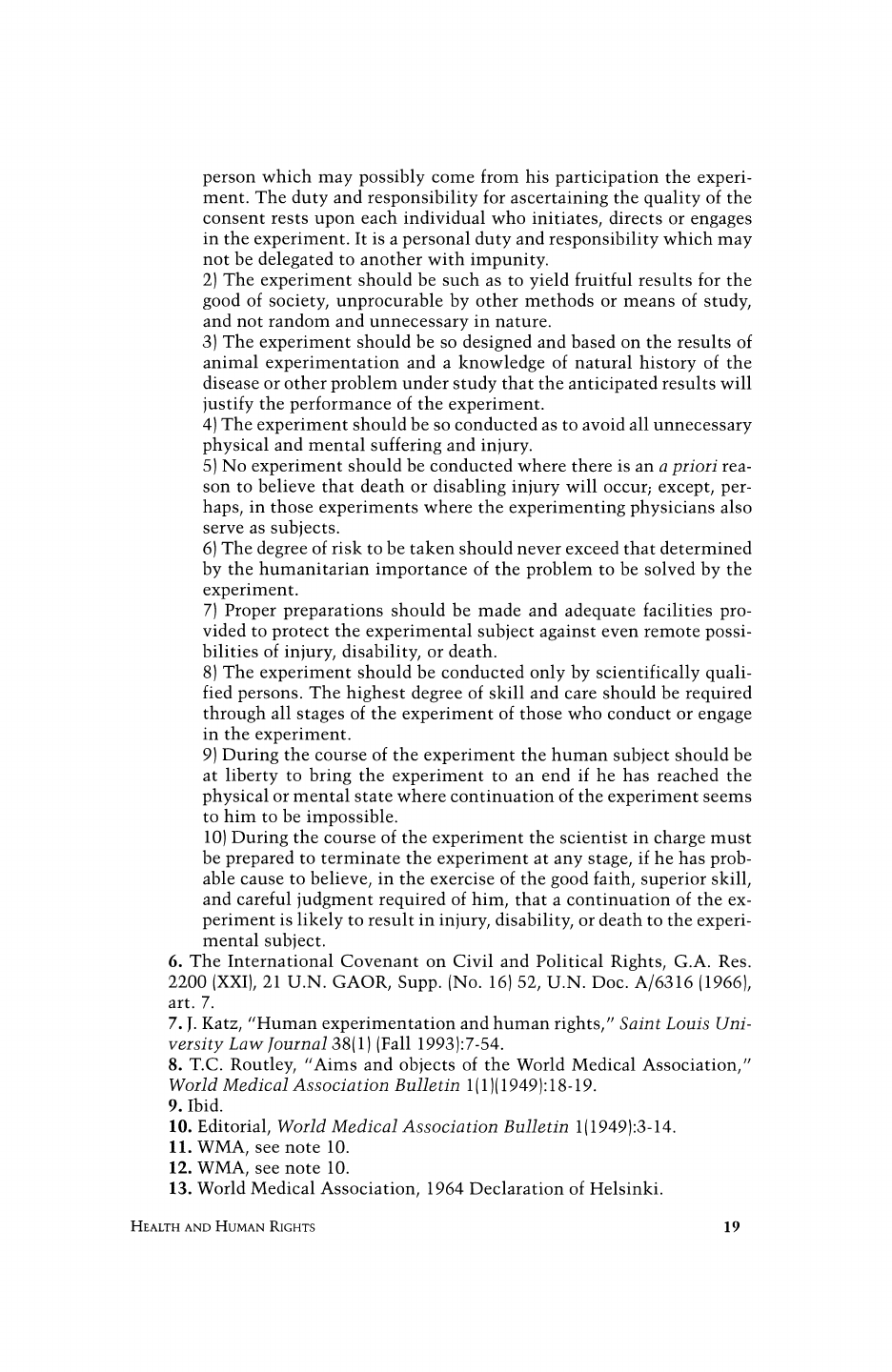
person which may possibly come
from his
participation the experi-
ment.
The
duty
and
responsibility
for
ascertaining
the
quality
of the
consent rests
upon
each
individual who initiates,
directs
or
engages
in
the experiment. It is a
personal duty and
responsibility which may
not
be delegated to another
with impunity.
2)
The experiment should
be such as to yield
fruitful results for the
good
of
society, unprocurable
by
other methods or means of
study,
and
not random and
unnecessary
in
nature.
3)
The experiment should
be so designed and
based on the results of
animal
experimentation
and
a
knowledge
of natural
history
of the
disease or other problem under
study
that
the
anticipated results will
justify
the
performance
of the
experiment.
4)
The experiment should
be so conducted as to
avoid all unnecessary
physical and mental
suffering and injury.
5)
No experiment should be conducted
where
there is
an
a priori rea-
son to believe that death or
disabling injury
will
occur; except, per-
haps,
in
those
experiments
where the
experimenting physicians
also
serve as
subjects.
6)
The
degree
of risk to be taken should
never exceed that determined
by
the humanitarian
importance
of the
problem
to be solved
by
the
experiment.
7)
Proper preparations should
be made and
adequate facilities pro-
vided to
protect
the
experimental
subject against even remote
possi-
bilities of
injury, disability,
or death.
8)
The
experiment
should
be conducted
only by
scientifically quali-
fied
persons.
The
highest
degree of skill and care should be
required
through
all
stages
of the
experiment
of those who conduct or
engage
in the
experiment.
9)
During
the
course of the
experiment the human
subject
should be
at
liberty
to
bring
the
experiment
to an end if he has reached the
physical
or mental state
where continuation of the
experiment
seems
to him to be
impossible.
10)
During the course of the
experiment the
scientist
in
charge must
be
prepared
to terminate the
experiment
at
any
stage,
if he has
prob-
able cause to
believe,
in the
exercise of the
good
faith, superior skill,
and careful
judgment required
of
him,
that
a continuation of the ex-
periment
is
likely
to result
in
injury, disability,
or death
to the
experi-
mental
subject.
6. The International Covenant
on Civil and Political
Rights,
G.A.
Res.
2200
(XXI),
21
U.N.
GAOR,
Supp. (No. 16) 52,
U.N. Doc.
A/6316 (1966),
art.
7.
7.
J.
Katz,
"Human
experimentation
and
human
rights," Saint Louis Uni-
versity
Law Journal
38(1) (Fall
1993):7-54.
8.
T.C.
Routley,
"Aims and
objects
of the
World Medical
Association,"
World Medical Association Bulletin
1(1)(1949):
18-19.
9. Ibid.
10.
Editorial,
World
Medical Association Bulletin
1(1949):3-14.
11.
WMA,
see note 10.
12.
WMA,
see note 10.
13. World Medical
Association,
1964
Declaration of
Helsinki.
HEALTH
AND
HUMAN
RIGHTS
19

14.
G.J. Annas,
"The
changing
landscape
of
human experimentation:
Nuremberg,
Helsinki,
and beyond,"
Health Matrix: Journal
of
Law-Medi-
cine
2(1992):119-140.
15.
On the WMA election
of a
former
member
of the Nazi
party
as presi-
dent-elect,
see M.A.
Grodin, G.J.
Annas
and L.H.
Glantz, "Medicine
and
Human
Rights:
A Proposal
for
International
Action,"
Hastings
Center
Report
23(4)(1993):8-12.
16.
Working
Party,
British Medical
Association,
Medicine
Betrayed:
The
Participation
of Doctors
in Human
Rights
Abuses
(London:
Zed
Books,
1992).
(EDITOR'S
NOTE: See
J. Leaning,
this
issue,
for review
of this
book).
17.
G.J.
Annas,
"Hunger
Strikes," British
Medical
Journal
31 1(October
1995):
1114-15.
18.
Some hospitalized
patients,
for example,
may be as
vulnerable
to au-
thoritarian
measures
as prisoners.
In
the
most famous
case
in the U.S.,
a
competent young
woman,
Elizabeth Bouvia,
was
continually
force-fed
in
a California
hospital
after she threatened
to
starve
herself to death.
Al-
though she
was almost totally
paralyzed
from the
neck down,
four
or more
attendants
were
required
to
daily
wrestle with
her
and restrain
her while
a
nasogastric
tube was forced through
her nose and into
her
stomach. Her
right
to refuse
such "treatment"
was
ultimately
vindicated
by
the Cali-
fornia
courts,
which have recently
also ruled that prisoners
retain
this
right
of refusal
as well.
Legal
authority
is
not the same
thing
as ethical
conduct,
but
U.S.
courts have held
that a
prisoner
who
is on a hunger
strike to obtain
a transfer or for better
living
conditions
may
legally be
force-fed
if
necessary
to
preserve
"order"
in
the
prison
setting. G.J.
Annas,
"When
suicide
prevention
becomes
brutality:
The case of Elizabeth
Bouvia,"
Hasting
Center
Report
14(2) (1984):20-21;
Thor v.
Superior
Court,
5 Cal.
4th
725,
855
P.2d
375
(1993);
G.J. Annas,
"Prison
Hunger
Strikes:
Why
motive matters,"
Hastings Center
Report
12(6)
(1982):21-22.
19.
Ethical statement:
"Artificial feeding of prisoners,"
British
Medical
Journal
(1974):52-53.
20.
World
Medical Association,
Declaration
of
Malta on
Hunger
Strikers
(adopted
by
the 43rd World
Medical
Assembly
in
Malta
in
1991
and
re-
vised at
the 44th
Assembly
in Marbella
in
1992).
21.
This
seminar was
the
basis for a pamphlet
that has
just been
made
available
in
English.
The
pamphlet
itself relies heavily
on
the British
Medical Association's 1992
Working
Group
report,
Medicine
Betrayed:
The
Participation
of
Doctors
in
Human
Rights
Abuses and
reprints
the
report's
chapter
on hunger
strikes as its introduction.
Johannes
Wier
Foun-
dation
for Health
and Human
Rights,
Assistance
in
Hunger
Strikes:
A
Manual
for
Physicians
and Other Health Personnel Dealing
with
Hunger
Strikers
(Amersfoort:
Johannes
Wier
Foundation for Health
and Human
Rights,
1995),
pp.
5-12;
British Medical
Association,
see note 16.
22.
Perhaps
the
most
arresting
aspect
of
the Dutch document,
represent-
ing
as
it does the
philosophy
of members of
the
only
society
to
approve
of
physician
killing,
is what it leaves out.
While the document
was
being
prepared
in
early 1993,
a
65-year
old Dutch cancer patient
went on
a hun-
ger
strike after
her
physician
refused
to end her life
through
mercy
kill-
ing.
After
12
days
of a
highly-publicized
hunger
strike,
her
request
for
20
Vol. 2 No.
1
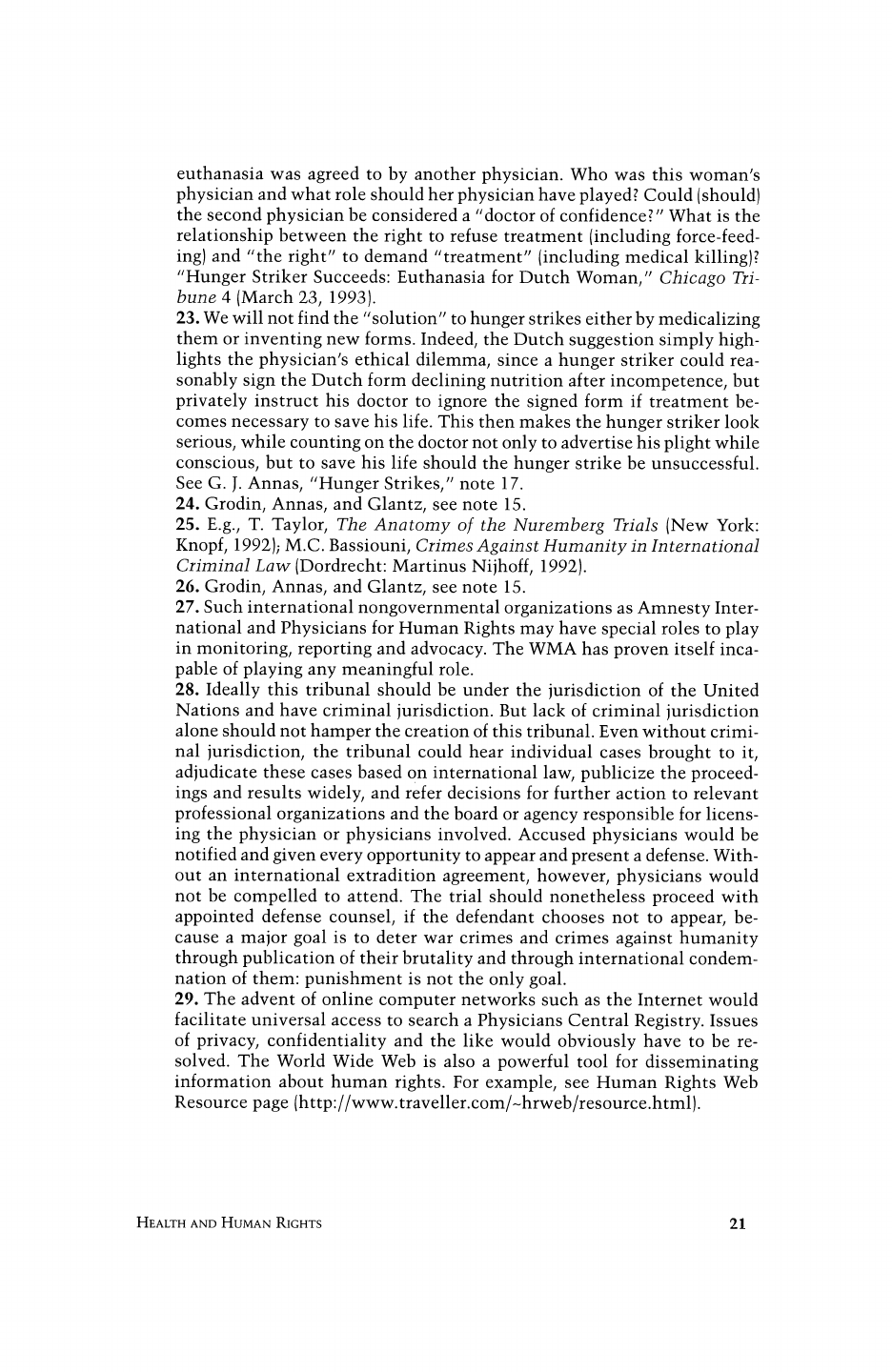
euthanasia
was
agreed to
by
another
physician.
Who
was this
woman's
physician and
what
role
should
her
physician
have
played?
Could
(should)
the
second
physician
be
considered a
"doctor of
confidence?
"
What is
the
relationship
between the
right
to
refuse
treatment
(including
force-feed-
ing) and
"the
right"
to
demand
"treatment"
(including
medical
killing)?
"Hunger
Striker
Succeeds:
Euthanasia
for
Dutch
Woman,"
Chicago
Tri-
bune 4
(March
23,
1993).
23. We
will
not find
the
"solution"
to
hunger
strikes
either
by
medicalizing
them or
inventing
new
forms.
Indeed,
the
Dutch
suggestion
simply
high-
lights
the
physician's ethical
dilemma,
since
a
hunger
striker could
rea-
sonably
sign the
Dutch form
declining
nutrition after
incompetence,
but
privately
instruct his
doctor to
ignore
the
signed
form if
treatment
be-
comes
necessary to save his
life. This then
makes
the
hunger
striker look
serious, while
counting
on
the doctor not
only to
advertise his
plight while
conscious,
but to save
his
life should
the
hunger
strike be
unsuccessful.
See G. J.
Annas,
"Hunger
Strikes,"
note
17.
24.
Grodin,
Annas,
and
Glantz,
see
note 15.
25. E.g.,
T.
Taylor,
The
Anatomy of
the
Nuremberg
Trials (New
York:
Knopf,
1992);
M.C.
Bassiouni,
Crimes
Against
Humanity
in
International
Criminal
Law
(Dordrecht:
Martinus
Nijhoff,
1992).
26.
Grodin,
Annas, and
Glantz,
see
note 15.
27. Such
international
nongovernmental
organizations as
Amnesty
Inter-
national and
Physicians
for
Human
Rights
may
have
special
roles
to
play
in
monitoring,
reporting
and
advocacy. The WMA has
proven
itself
inca-
pable
of
playing any
meaningful
role.
28.
Ideally this tribunal
should be
under the
jurisdiction of
the United
Nations and
have criminal
jurisdiction. But lack
of criminal
jurisdiction
alone
should not
hamper
the
creation of
this tribunal. Even
without crimi-
nal
jurisdiction,
the
tribunal could
hear
individual cases
brought
to
it,
adjudicate these cases based
on
international
law, publicize
the
proceed-
ings
and
results
widely,
and
refer
decisions for further
action to
relevant
professional
organizations and the
board or
agency
responsible
for licens-
ing
the
physician
or
physicians
involved.
Accused
physicians would be
notified
and
given
every
opportunity
to
appear and
present
a
defense. With-
out an
international
extradition
agreement,
however,
physicians
would
not be
compelled
to attend.
The trial
should
nonetheless
proceed
with
appointed defense
counsel,
if
the
defendant
chooses not to
appear,
be-
cause a
major
goal
is to deter war
crimes and
crimes
against
humanity
through
publication
of their
brutality
and
through
international
condem-
nation of them:
punishment is not the
only goal.
29. The advent
of online
computer networks such as
the Internet would
facilitate
universal
access to search a
Physicians
Central
Registry.
Issues
of
privacy,
confidentiality
and the
like would
obviously
have
to be re-
solved.
The World
Wide Web
is also a
powerful
tool for
disseminating
information
about human
rights.
For
example,
see Human
Rights
Web
Resource
page
(http://www.traveller.com/-hrweb/resource.html).
HEALTH
AND HUMAN
RIGHTS
21
